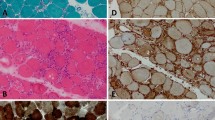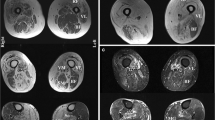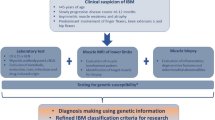Abstract
Inclusion body myositis is a progressive disease of the skeletal muscle. Here, specific theories of its pathogenesis are reviewed and general considerations pertaining to modeling of this disease discussed. Understanding of inclusion body myositis disease mechanism remains extremely poor. Current published animal models do not represent the disease. Future studies need to consider the critical role of biomarkers and methodologic issues in their discovery.

Similar content being viewed by others
References
Papers of particular interest, published recently, have been highlighted as: • Of importance •• Of major importance
Yunis EJ, Samaha FJ: Inclusion body myositis. Lab Invest 1971, 25:240–248.
• Machado P, Miller A, Holton J, Hanna M: Sporadic inclusion body myositis: an unsolved mystery. Acta Reumatol Port 2009, 34:161–182. This is a comprehensive review of many aspects of IBM.
Karpati G, O’Ferrall EK: Sporadic inclusion body myositis: pathogenic considerations. Ann Neurol 2009, 65:7–11.
Greenberg SA: Inclusion body myositis: review of recent literature. Curr Neurol Neurosci Rep 2009, 9:83–89.
Askanas V, Engel WK, Nogalska A: Inclusion body myositis: a degenerative muscle disease associated with intra-muscle fiber multi-protein aggregates, proteasome inhibition, endoplasmic reticulum stress and decreased lysosomal degradation. Brain Pathol 2009, 19:493–506.
• Needham M, Mastaglia FL: Sporadic inclusion body myositis: a continuing puzzle. Neuromuscul Disord 2008, 18:6–16. This is a thoughtful review of IBM mechanistic theories.
• Greenberg SA: Inflammatory myopathies: disease mechanisms. Curr Opin Neurol 2009, 22:516–523. This is a review of inflammatory myopathy disease mechanisms that focuses on dermatomyositis and IBM.
Askanas V, Engel WK: Inclusion-body myositis: a myodegenerative conformational disorder associated with Abeta, protein misfolding, and proteasome inhibition. Neurology 2006, 66(2 Suppl 1):S39–S48.
• Greenberg SA: How citation distortions create unfounded authority: analysis of a citation network. BMJ 2009, 339:b2680. This article rigorously demonstrates how distortions in the scholarly process of citation may create belief in unfounded claims, with particular attention paid to claims regarding Aβ in IBM.
Muth IE, Barthel K, Bahr M, et al.: Proinflammatory cell stress in sporadic inclusion body myositis muscle: overexpression of alphaB-crystallin is associated with amyloid precursor protein and accumulation of beta-amyloid. J Neurol Neurosurg Psychiatry 2009, 80:1344–1349.
Greenberg SA: Comment on ‘Interrelation of inflammation and APP in sIBM: IL-1{beta} induces accumulation of {beta}-amyloid in skeletal muscle.’ Brain 2009, 132:e106.
Askanas V, Sarkozi E, Bilak M, et al.: Human muscle macrophages express beta-amyloid precursor and prion proteins and their mRNAs. Neuroreport 1995, 6:1045–1049.
Sarkozi E, Askanas V, Johnson SA, et al.: Expression of beta-amyloid precursor protein gene is developmentally regulated in human muscle fibers in vivo and in vitro. Exp Neurol 1994, 128:27–33.
Sarkozi E, Askanas V, Johnson SA, et al.: beta-Amyloid precursor protein mRNA is increased in inclusion-body myositis muscle. Neuroreport 1993, 4:815–818.
Nalbantoglu J, Karpati G, Carpenter S: Conspicuous accumulation of a single-stranded DNA binding protein in skeletal muscle fibers in inclusion body myositis. Am J Pathol 1994, 144:874–882.
Greenberg SA, Sanoudou D, Haslett JN, et al.: Molecular profiles of inflammatory myopathies. Neurology 2002, 59:1170–1182.
Schmidt J, Barthel K, Wrede A, et al.: Interrelation of inflammation and APP in sIBM: IL-1 beta induces accumulation of beta-amyloid in skeletal muscle. Brain 2008, 131:1228–1240.
Fukuchi K, Pham D, Hart M, et al.: Amyloid-beta deposition in skeletal muscle of transgenic mice: possible model of inclusion body myopathy. Am J Pathol 1998, 153:1687–1693.
Jin LW, Hearn MG, Ogburn CE, et al.: Transgenic mice over-expressing the C-99 fragment of betaPP with an alpha-secretase site mutation develop a myopathy similar to human inclusion body myositis. Am J Pathol 1998, 153:1679–1686.
Sugarman MC, Yamasaki TR, Oddo S, et al.: Inclusion body myositis-like phenotype induced by transgenic overexpression of beta APP in skeletal muscle. Proc Natl Acad Sci U S A 2002, 99:6334–6339.
Strazielle C, Dumont M, Fukuchi K, Lalonde R: Transgenic mice expressing the human C99 terminal fragment of betaAPP: effects on cytochrome oxidase activity in skeletal muscle and brain. J Chem Neuroanat 2004, 27:237–246.
Kitazawa M, Green KN, Caccamo A, LaFerla FM: Genetically augmenting Abeta42 levels in skeletal muscle exacerbates inclusion body myositis-like pathology and motor deficits in transgenic mice. Am J Pathol 2006, 168:1986–1997.
Moussa CE, Fu Q, Kumar P, et al.: Transgenic expression of beta-APP in fast-twitch skeletal muscle leads to calcium dyshomeostasis and IBM-like pathology. FASEB J 2006, 20:2165–2167.
Sugarman MC, Kitazawa M, Baker M, et al.: Pathogenic accumulation of APP in fast twitch muscle of IBM patients and a transgenic model. Neurobiol Aging 2006, 27:423–432.
Kitazawa M, Trinh DN, LaFerla FM: Inflammation induces tau pathology in inclusion body myositis model via glycogen synthase kinase-3beta. Ann Neurol 2008, 64:15–24.
Rebolledo DL, Minniti AN, Grez PM, et al.: Inclusion body myositis: a view from the Caenorhabditis elegans muscle. Mol Neurobiol 2008, 38:178–198.
• Salajegheh M, Pinkus JL, Nazareno R, et al.: Nature of “Tau” immunoreactivity in normal myonuclei and inclusion body myositis. Muscle Nerve 2009, 40:520–528. The identity of SMI-31 immunoreactive material widely interpreted as phosphorylated tau was shown to likely be neurofilament H.
Maurage CA, Bussière T, Sergeant N, et al.: Tau aggregates are abnormally phosphorylated in inclusion body myositis and have an immunoelectrophoretic profile distinct from other tauopathies. Neuropathol Appl Neurobiol 2004, 30:624–634.
Delaunay A, Bromberg KD, Hayashi Y, et al.: The ER-bound RING finger protein 5 (RNF5/RMA1) causes degenerative myopathy in transgenic mice and is deregulated in inclusion body myositis. PLoS ONE 2008, 3:e1609.
Greenberg SA: Proposed immunologic models of the inflammatory myopathies and potential therapeutic implications. Neurology 2007, 69:2008–2019.
Engel AG, Arahata K: Monoclonal antibody analysis of mononuclear cells in myopathies. II: Phenotypes of autoinvasive cells in polymyositis and inclusion body myositis. Ann Neurol 1984, 16:209–215.
Greenberg SA, Bradshaw EM, Pinkus JL, et al.: Plasma cells in muscle in inclusion body myositis and polymyositis. Neurology 2005, 65:1782–1787. (Published erratum appears in Neurology 2006, 66:493.)
• Bradshaw EM, Orihuela A, McArdel SL, et al.: A local antigen-driven humoral response is present in the inflammatory myopathies. J Immunol 2007, 178:547–556. The intramuscular B-cell response in IBM was shown to be antigen driven, laying the groundwork for future antibody-based antigen discovery.
Salajegheh M, Lin YY, Parker KC, et al.: Using humoral immunity for the identification of candidate antigens in inclusion body myositis [abstract]. Neurology 2007, 68(Suppl 1):A361.
Banwell BL, Engel AG: AlphaB-crystallin immunolocalization yields new insights into inclusion body myositis. Neurology 2000, 54:1033–1041.
Chou SM: Myxovirus-like structures in a case of human chronic polymyositis. Science 1967, 158:1453–1455.
Chou SM: Myxovirus-like structures and accompanying nuclear changes in chronic polymyositis. Arch Pathol 1968, 86:649–658.
Carpenter S, Karpati G, Heller I, Eisen A: Inclusion body myositis: a distinct variety of idiopathic inflammatory myopathy. Neurology 1978, 28:8–17.
Carpenter S: Inclusion body myositis, a review. J Neuropathol Exp Neurol 1996, 55:1105–1114.
Karpati G, Carpenter S: Pathology of the inflammatory myopathies. Baillieres Clin Neurol 1993, 2:527–556.
Greenberg SA, Pinkus JL, Amato AA: Nuclear membrane proteins are present within rimmed vacuoles in inclusion-body myositis. Muscle Nerve 2006, 34:406–416.
• Weihl CC, Temiz P, Miller SE, et al.: TDP-43 accumulation in inclusion body myopathy muscle suggests a common pathogenic mechanism with frontotemporal dementia. J Neurol Neurosurg Psychiatry 2008, 79:1186–1189. This article found sarcoplasmic TDP-43, a protein normally seen only in nuclei, in biopsy samples from patients with IBM and valosin-containing protein mutation inclusion body myopathies.
•• Salajegheh M, Pinkus JL, Taylor JP, et al.: Sarcoplasmic redistribution of nuclear TDP-43 in inclusion body myositis. Muscle Nerve 2009, 40:19–31. TDP-43 presence in IBM was quantitated in relation to other reported biomarkers. The relation between this nucleic acid-binding protein and nuclear abnormalities is discussed.
Küsters B, van Hoeve BJ, Schelhaas HJ, et al.: TDP-43 accumulation is common in myopathies with rimmed vacuoles. Acta Neuropathol 2009, 117:209–211.
Olivé M, Janué A, Moreno D, et al.: TAR DNA-binding protein 43 accumulation in protein aggregate myopathies. J Neuropathol Exp Neurol 2009, 68:262–273.
Capsoni S, Ruberti F, Di Daniel E, Cattaneo A: Muscular dystrophy in adult and aged anti-NGF transgenic mice resembles an inclusion body myopathy. J Neurosci Res 2000, 59:553–560.
Chen X, Ghribi O, Geiger JD: Rabbits fed cholesterol-enriched diets exhibit pathological features of inclusion body myositis. Am J Physiol Regul Integr Comp Physiol 2008, 294:R829–R835.
Kitazawa M, Vasilevko V, Cribbs DH, LaFerla FM: Immunization with amyloid-beta attenuates inclusion body myositis-like myopathology and motor impairment in a transgenic mouse model. J Neurosci 2009, 29:6132–6141.
Koistinen H, Prinjha R, Soden P, et al.: Elevated levels of amyloid precursor protein in muscle of patients with amyotrophic lateral sclerosis and a mouse model of the disease. Muscle Nerve 2006, 34:444–450.
Yang CC, Alvarez RB, Engel WK, Askanas V: Increase of nitric oxide synthases and nitrotyrosine in inclusion-body myositis. Neuroreport 1996, 8:153–158.
Acknowledgment
This work is supported in part by a grant to Dr. Greenberg from the National Institutes of Health (R21NS057225).
Disclosure
Dr. Greenberg has served as a consultant regarding clinical trial planning for MedImmune and has a sponsored research agreement with MedImmune. He is also an inventor of intellectual property pertaining to myositis diagnostics.
Author information
Authors and Affiliations
Corresponding author
Rights and permissions
About this article
Cite this article
Greenberg, S.A. Theories of the Pathogenesis of Inclusion Body Myositis. Curr Rheumatol Rep 12, 221–228 (2010). https://doi.org/10.1007/s11926-010-0102-5
Published:
Issue Date:
DOI: https://doi.org/10.1007/s11926-010-0102-5




